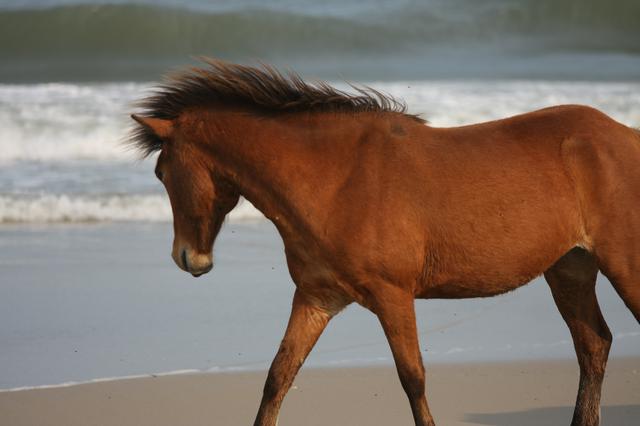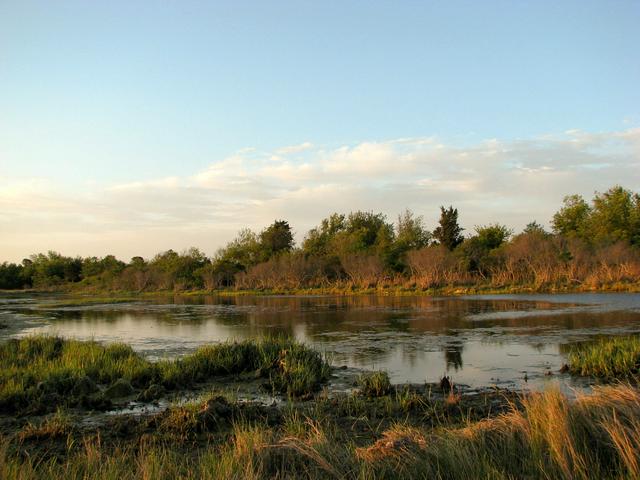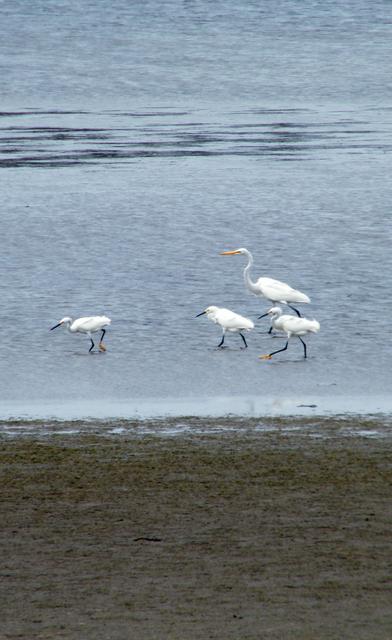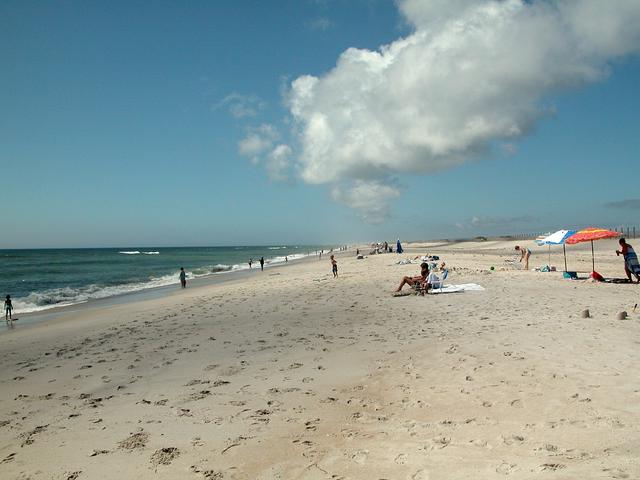
Assateague Island is a beautiful barrier island, administrated by park services, permanently uninhabited, and most famous for its charismatic wild ponies. The northern tip of the island is a Maryland state park, while the rest of the Maryland section of the island is a United States National Seashore. The southern third of the island runs into Virginia, and is managed by the Chincoteague National Wildlife Refuge. It is completely uninhabited, and open only to daytime canoe/kayak and foot visits.
Assateague Island National Park was established in 1943. The island has of beach, a forest, as well as saltwater marsh and freshwater marsh habitats. This habitat is home to migratory birds, plants, and of course wild ponies. There are many different theories to how the ponies got to the island; some say they are survivors of a shipwreck, but there is no evidence to support this. Others say that someone put the ponies over on the island so that they could avoid fencing laws.
More than half of Assateague Island National Seashore's is near-shore and estuarine waters, and the interplay between these waters and the barrier island affects nearly every aspect of life in this dynamic coastal environment.
The geography of the island itself is in a state of constant flux, continuously being reshaped by the elemental forces of wind and water. Powerful storms can dramatically alter the shoreline in a matter of hours, as waves wash over the beach and reshape the island from ocean to bay. Other forces sculpt the landscape in less obvious ways. Exposure to salt spray, lack of fresh water, and isolation from the mainland are subtle, but powerful influences on the Island's species composition. Over time, these conditions have produced a community of plants and animals uniquely suited to the extremes found at the edge of the sea.

While Assateague's wild horses are perhaps the island's best-known inhabitants, other large mammals also roam the park, including the native white-tailed deer (Odocoileus virginianus) and the non-native sika deer (Cervus japonica), a diminutive species of Asian elk introduced to Assateague during the 1920s.
Other inhabitants are less conspicuous than the large mammals. Seven species of frogs and toads depend on fresh water ponds in the center of the island for breeding, and a variety of snakes, such as the black rat snake (Elaphe obsoleta obsoleta), can be found across the forests, dunes, and marshes preying on rodents, small birds, or toads. Numerous invertebrates such as fiddler crabs (Uca ssp.) and mud snails (Nassarius ssp.) play key roles in maintaining the health of the island's salt marshes. Even the seemingly barren beaches provide habitat for nocturnal ghost crabs (Ocypode quadrata), red fox (Vulpes vulpes), and raccoons (Procyon lotor), who scavenge the crustaceans, fish, and other organic matter washed in by the tides.
Many bird species make their home on Assateague on a seasonal basis. Shorebirds by the tens of thousands depend upon the island's protected foraging and resting areas during their twice-yearly transcontinental migrations. Each fall, large flocks of waterfowl such as snow geese (Chen caerulescens) begin arriving at Assateague where they will spend the winter traveling between the sheltered bay and salt marshes and fallow farm fields on the mainland.
Finally, the coastal waters that surround Assateague Island teem with animal life. The sheltered, nutrient rich waters of the estuary formed by the island provide ideal breeding and spawning habitat for many aquatic species, some of which, like the blue crab (Callinectes sapidus), are commercially important to the local area. Each spring a variety of fish, including spot (Leiostomus xanthrurus), Atlantic menhaden (Brevoortia tyrannus) and summer flounder (Paralichthys dentatus) migrate into the estuary to breed. Later, the juvenile fish provide an abundant food source for birds, marine mammals, and larger fish.
Summers are generally hot and humid, albeit less humid than inland. It rarely snows in the winter but there is often a damp cold. At any time of year, come prepared for potential high winds, and always for intense and unrelenting, inescapable sun!
See #Sleep for details on camping fees
Entrance fees are $3 for individuals on foot or $20 for private vehicles. Both fees are good for seven days. A $30 annual pass is available, allowing free entry for one year.
Standard day use is $4/person for Maryland residents Memorial Day-Labor Day, $3 Memorial Day-Labor Day $4/person. Non-Maryland residents pay $6/person.
Pets are permitted on the Maryland side of the island, including overnight, but must remain confined or on a leash no longer than six feet. All pets are expressly prohibited in the Virginia Wildlife Refuge.
The Assateague Light House was built in 1833 and is 142 feet tall, it was first lit in January 1833. On October 1, 1867, A new lens was put in and it could be seen for up to nineteen miles. This lighthouse is now only open a few times a year for tours.
 The wildlife and wild ponies are without a doubt the star attractions. Bird watching is one of the more popular activities in Assaeague, but most people come to see the wild ponies. There are different theories to how the ponies got to the island: some say they are survivors of a shipwreck, but there is no direct evidence of this. Others say that someone put the ponies over on the island so that they could avoid fencing laws. To catch the ever popular pictures of the ponies walking by the surf, the ponies favorite beach times are early morning around sunrise, late afternoon, and sunset. Around mid-day, the ponies are more easily found either by the road, poking around the campsites, or a little less often on the marsh side of the island. Ponies seem to love to go in the middle of the road after dark. You are a lot more likely to see them in the National Park than the State Park.
The wildlife and wild ponies are without a doubt the star attractions. Bird watching is one of the more popular activities in Assaeague, but most people come to see the wild ponies. There are different theories to how the ponies got to the island: some say they are survivors of a shipwreck, but there is no direct evidence of this. Others say that someone put the ponies over on the island so that they could avoid fencing laws. To catch the ever popular pictures of the ponies walking by the surf, the ponies favorite beach times are early morning around sunrise, late afternoon, and sunset. Around mid-day, the ponies are more easily found either by the road, poking around the campsites, or a little less often on the marsh side of the island. Ponies seem to love to go in the middle of the road after dark. You are a lot more likely to see them in the National Park than the State Park.
The beaches are spectacular--huge white sand beaches on the Atlantic, unmarred by any buildings in any direction. (Although the beach is thoroughly marred by all the OSVs once you go south of South Ocean Beach.) Lifeguards are present during swimming season at the main section of the State Park's beach, and at North Ocean Beach in the National Park. The National Park beaches are lifeguarded only on holiday weekends, and from mid-July to the end of August. The water tends to be a little bit rough, but still OK for swimming. One of the more fun walks is to head north of the main swimming area in the State Park towards the northern tip of the island (and indeed, it does come to a narrow sandbar, where you can stand, surrounded by surf. This area is notionally and unofficially "clothing-optional," but it's rare to see anyone actually disrobe.
 Aside from the obvious swimming, taking a walk along the Life of the Dunes and the Life of the Forest trails in the National Park is highly recommended. You will learn a lot about barrier island ecosystems in the process (especially if coupled with a free visit to the National Park Visitor Center on the mainland side of the Verrazzano Bridge). They are also fabulous opportunities for wildlife viewing and photography. A colorful sunset over the marsh on the bayside of the forest trail is unforgettable. Bug spray with DEET is requisite for the trails, and long pants and long sleeves are also quite handy.
Aside from the obvious swimming, taking a walk along the Life of the Dunes and the Life of the Forest trails in the National Park is highly recommended. You will learn a lot about barrier island ecosystems in the process (especially if coupled with a free visit to the National Park Visitor Center on the mainland side of the Verrazzano Bridge). They are also fabulous opportunities for wildlife viewing and photography. A colorful sunset over the marsh on the bayside of the forest trail is unforgettable. Bug spray with DEET is requisite for the trails, and long pants and long sleeves are also quite handy.
- Surf fishing is another popular activity, which will require both a fee and permit from either visitor center. Fishing is permitted away from the lifeguarded area of the parks (using commonsense to avoid getting too close to swimmers), as well as the bayside near the boat launches.
- MD Coastal Bays Rentals, +1 410 213-2297. Mid-April-Memorial Day: Sa-Su 10AM-4PM (last launch at 3PM); Memorial Day-Labor Day: 9AM-6PM daily (last at 4:30PM); Labor Day-mid-October: Sa-Su 10AM-4PM (last launch at 3PM). Canoes, kayaks, and paddleboards are available for rental mid-April through mid-October from the stand at the boat launch in the National Park. This is a great way to explore the beautiful marsh side of the island. Rentals will not be available in case of any small craft safety advisories. The boat launch also rents clam rakes and bicycles. Kayak: $15/hour, $45/day, $65 overnight, $80 weekend; double kayak: $20/hour; canoe: $10/hour, $40/day, $60/overnight, $75 weekend; paddle boards: $25/hour, $40/2 hrs; bicycle: $6/hour, $20/day, $30/overnight, $45 weekend; clam rakes: $3/hour, $10/day, $15 overnight, $20 weekend. Weekend rates: F afternoon - Su afternoon.
- Over Sand Vehicles. Driving on the beach is permitted south of South Ocean Beach in the National Park for approved vehicles with a permit (make sure you know what you are doing, or you will get stuck). The way to make this a day is most certainly to bring some fishing rods and a picnic (locked in your car to avoid attracting ponies). Permits cost $80-150 depending on what you plan to do, and are good for one year. Make sure to read over the OSV brochure if interested . It is possible to camp overnight with your vehicle in the Bullpen at kilometer 21.
- Pony Penning Day. On the last Thursday in July thousands of tourist come to watch the "Saltwater Cowboys" swim the ponies from Assateague Island to Chincoteague Island. One of the best ways to see the Wild Ponies swim is on a Scenic Boat Tour.
Surf fishing is another popular activity, which will require both a fee and permit from either visitor center. Fishing is permitted away from the lifeguarded area of the parks (using commonsense to avoid getting too close to swimmers), as well as the bayside near the boat launches.
MD Coastal Bays Rentals, +1 410 213-2297. Mid-April-Memorial Day: Sa-Su 10AM-4PM (last launch at 3PM); Memorial Day-Labor Day: 9AM-6PM daily (last at 4:30PM); Labor Day-mid-October: Sa-Su 10AM-4PM (last launch at 3PM). Canoes, kayaks, and paddleboards are available for rental mid-April through mid-October from the stand at the boat launch in the National Park. This is a great way to explore the beautiful marsh side of the island. Rentals will not be available in case of any small craft safety advisories. The boat launch also rents clam rakes and bicycles. Kayak: $15/hour, $45/day, $65 overnight, $80 weekend; double kayak: $20/hour; canoe: $10/hour, $40/day, $60/overnight, $75 weekend; paddle boards: $25/hour, $40/2 hrs; bicycle: $6/hour, $20/day, $30/overnight, $45 weekend; clam rakes: $3/hour, $10/day, $15 overnight, $20 weekend. Weekend rates: F afternoon - Su afternoon.
Over Sand Vehicles. Driving on the beach is permitted south of South Ocean Beach in the National Park for approved vehicles with a permit (make sure you know what you are doing, or you will get stuck). The way to make this a day is most certainly to bring some fishing rods and a picnic (locked in your car to avoid attracting ponies). Permits cost $80-150 depending on what you plan to do, and are good for one year. Make sure to read over the OSV brochure if interested . It is possible to camp overnight with your vehicle in the Bullpen at kilometer 21.
Pony Penning Day. On the last Thursday in July thousands of tourist come to watch the "Saltwater Cowboys" swim the ponies from Assateague Island to Chincoteague Island. One of the best ways to see the Wild Ponies swim is on a Scenic Boat Tour.
On the last Thursday in July is Pony Penning day and an auction is held to sell wild ponies from Assateague. They do this to make sure the ponies do not over populate the island. Many tourist love to watch the auctions as well as see the "salt water cowboys" swim the herd from Assateague to Chincoteague.
Aside from buying horses one day per year, the National Park Visitor Center is a good stop for some souvenirs, as is the gas station/general store just west on MD-611.
There is no food on the island other than what you bring, and you absolutely must keep all food either in your car or in an airtight canister, unless you fancy getting bitten/stepped on by horses. There's no need to rough it, though, as there are dining options a short car ride away. And of course, there is always Ocean City.
- Assateague Crab House, 7643 MD-611, +1 410 641-4330. Memorial Day weekend-Labor Day: noon-10PM daily. This is the closest restaurant to the island, and its seasonal opening reflects its principal trade in tourist traffic (and just that it's a crab house). The crabs are fun, albeit not the best in the state, whereas the fried chicken really shines. For larger groups, the all you can eat specials of crabs, chicken, plus sides are great. Remember, true Maryland surf and turf is steamed Blue crabs plus skillet fried chicken! $10-35.
- Decatur Diner, 9609 MD-611, +1 443 664-6779. Su-Th 7AM-3PM, F-Sa 7AM-8PM. This is just a no-frills roadside diner done well. It's just far off the beaten path to keep the prices nice and low. Breakfast served all day, with some fun regional specialties like crab omelets and scrapple omelets. The Pipeline, along with the Pipeline Burger, is their comically big heap of everything, topped with cheese and an extra dash of grease! $4-14.
Assateague Crab House, 7643 MD-611, +1 410 641-4330. Memorial Day weekend-Labor Day: noon-10PM daily. This is the closest restaurant to the island, and its seasonal opening reflects its principal trade in tourist traffic (and just that it's a crab house). The crabs are fun, albeit not the best in the state, whereas the fried chicken really shines. For larger groups, the all you can eat specials of crabs, chicken, plus sides are great. Remember, true Maryland surf and turf is steamed Blue crabs plus skillet fried chicken! $10-35.
Decatur Diner, 9609 MD-611, +1 443 664-6779. Su-Th 7AM-3PM, F-Sa 7AM-8PM. This is just a no-frills roadside diner done well. It's just far off the beaten path to keep the prices nice and low. Breakfast served all day, with some fun regional specialties like crab omelets and scrapple omelets. The Pipeline, along with the Pipeline Burger, is their comically big heap of everything, topped with cheese and an extra dash of grease! $4-14.
Assateague has sinks and water fountains next to each bathroom. The water is perfectly safe to drink.
Campers are permitted to bring their own alcoholic beverages. Those under 21 should be exceedingly discreet, however, as the Park Police have recently begun cracking down on underage drinking, and those under 21 caught in possession of alcohol can expect a hefty fine ($300).
The two good watering holes up MD-611 are the aforementioned Pepper's Tavern, and the Green Turtle West. Nearby Ocean City, of course, has endless nightlife options, which most assuredly will be busier and more caffeinated than Berlin bars. Be extra sure to have a designated driver, as the Assateague roads are dark, and hitting wildlife is an ever-present danger!
- Green Turtle west, 9616 MD-611, +1 410 213-1500. Some good beers on tap, along with decent bar food (especially the hot wings) complement the main attraction, which is the busy bar filled with HD-TVs to watch just about any game that's on. Maryland teams, naturally, are the local favorites.
Green Turtle west, 9616 MD-611, +1 410 213-1500. Some good beers on tap, along with decent bar food (especially the hot wings) complement the main attraction, which is the busy bar filled with HD-TVs to watch just about any game that's on. Maryland teams, naturally, are the local favorites.
The usual beach hazards of drowning, riptides, sunburn, dehydration, etc. all apply to Assateague, although you can expect life guards during the busy season, particularly at the public beach at the State Park. Sunburn tends to be a bigger concern here than at many beaches, simply because there are no edifices to provide a retreat—lather up!
The ponies are beautiful, and a big part of the reason that people come to see the island, but they are wild animals, and they will charge, kick, and bite if you get too close or otherwise provoke them. The Park Service recommends never approaching them closer than ten feet, although fifteen feet might be a better rule of thumb. Under no circumstances should you try to feed them.
Beach campers far and wide know Assateague as the biting insect hell hole of the Mid-Atlantic. It cannot be emphasized enough that a visit in the warm months without a good bottle or two of insect repellent with DEET can be a nightmare, and will likely end with you speeding off in your car, clawing wildly at your wounds. You can enjoy your trip quite a bit, and quite comfortably if you simply remember to keep the bug spray handy, and to either stay in your tent with a good book or drive to a local restaurant during the buggy dawny and dusky portions of the day. If you are going over to the bay side, wear long pants and long sleeves, and perhaps a hat. The woods along the trails between the bay and beach sides of the island are by far the worst infested with the insidious little monsters.
Horses love the campsites, they probably love your tent in particular, and they particularly love any and all accessible food. If you have food, it's really best to just keep it on your person or in the car. If you are backcountry camping, and this is therefore not a viable option, bear canisters or some other airtight (preferably double-bagged) contraption will be necessary to keep the horses out of your tent. If there are quadrupeds milling about your insect/sun refuge, and you want them to move off, clap your hands loudly, while keeping your distance, and they should meander off.
It's unlikely that you will have a problem on any given visit, but Assateague occasionally can be a very windy place. Happily this drives away the insects, but the beach can be unpleasant if the sand starts picking up (another reason why it's good to bring some lightweight long-sleeves and pants). And tents have a tendency to fly away even when the wind isn't that strong, as the camping ground is soft. Bring long stakes for the tents, and possibly sand anchors.
